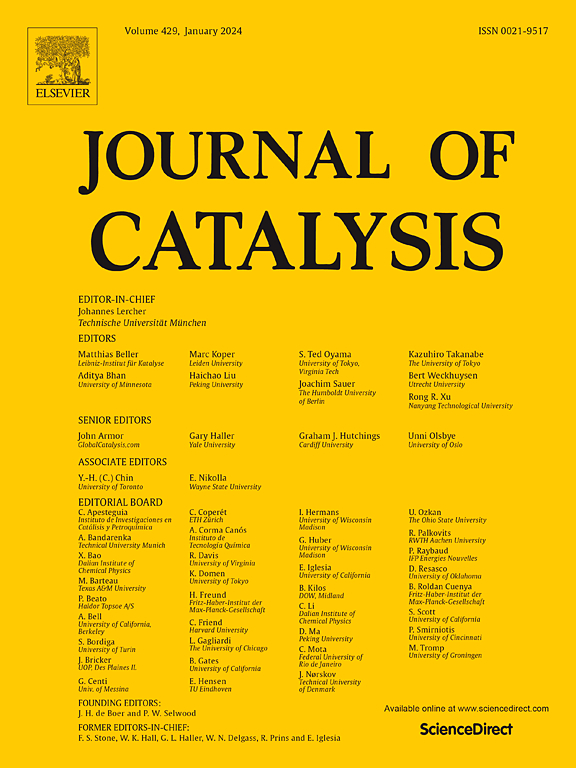Conversion of furfuryl alcohol to 1,5-pentanediol over tetrametallic Cu/CoOx/MgO/Al2O3 mixed metal oxide catalyst
IF 6.5
1区 化学
Q2 CHEMISTRY, PHYSICAL
引用次数: 0
Abstract
The hydrogenolysis of furfuryl alcohol to 1,5-pentanediol is investigated over a tetrametallic Cu/CoOx/MgO/Al2O3 catalytic system. Activity and characterization results suggested the specific roles of each metal: Cu0 dissociates H2, whereas CoOx, as a reducible oxide, generates Coδ+ sites next to oxygen vacancies where furfuryl alcohol adsorbs. Activated hydrogen spills over from Cu0 to these coordinatively unsaturated Coδ+ sites, enabling the hydrogenolysis of furfuryl alcohol to 1,5-pentanediol. Furthermore, Cu0 aids in the reduction of Co oxide species at lower temperatures during the catalyst activation, thereby promoting the generation of uncoordinated Coδ+ sites. The presence of MgO decreases overall acidity, resulting in reduced hydrogenolysis of furfuryl alcohol to 2-methylfuran and increased selectivity towards 1,5-pentanediol. Finally, the presence of Al2O3 in the catalyst enhances metal dispersion reducing the furanic ring hydrogenation to yield tetrahydrofurfuryl alcohol. With the optimized catalyst, a 43.8 % 1,5-pentanediol yield is obtained at 160 °C for 4 h in ethanol, achieving a TOF of 27.4 mol1,5-PDO mol−1A.S. h−1.

四金属Cu/CoOx/MgO/Al2O3混合金属氧化物催化剂催化糠醇制1,5-戊二醇的研究
研究了四金属Cu/CoOx/MgO/Al2O3催化体系中糠醇氢解制1,5-戊二醇的反应。活性和表征结果表明了每种金属的特定作用:Cu0离解H2,而CoOx作为一种可还原的氧化物,在氧空位附近产生Coδ+位点,从而吸附糠醇。活化氢从Cu0溢出到这些配位不饱和的Coδ+位点,使糠醇氢解为1,5-戊二醇。此外,在催化剂活化过程中,Cu0有助于Co氧化物在较低温度下的还原,从而促进非配位Coδ+位点的产生。氧化镁的存在降低了整体酸度,导致糠醇氢解反应减少,生成2-甲基呋喃,增加了对1,5-戊二醇的选择性。最后,催化剂中Al2O3的存在增强了金属的分散,减少了呋喃环加氢生成四氢呋喃醇。采用优化后的催化剂,在160 ℃、4 h的条件下,1,5-戊二醇的产率为43.8% %,TOF为27.4 mol1,5- pdo mol−1as。h−1。
本文章由计算机程序翻译,如有差异,请以英文原文为准。
求助全文
约1分钟内获得全文
求助全文
来源期刊

Journal of Catalysis
工程技术-工程:化工
CiteScore
12.30
自引率
5.50%
发文量
447
审稿时长
31 days
期刊介绍:
The Journal of Catalysis publishes scholarly articles on both heterogeneous and homogeneous catalysis, covering a wide range of chemical transformations. These include various types of catalysis, such as those mediated by photons, plasmons, and electrons. The focus of the studies is to understand the relationship between catalytic function and the underlying chemical properties of surfaces and metal complexes.
The articles in the journal offer innovative concepts and explore the synthesis and kinetics of inorganic solids and homogeneous complexes. Furthermore, they discuss spectroscopic techniques for characterizing catalysts, investigate the interaction of probes and reacting species with catalysts, and employ theoretical methods.
The research presented in the journal should have direct relevance to the field of catalytic processes, addressing either fundamental aspects or applications of catalysis.
 求助内容:
求助内容: 应助结果提醒方式:
应助结果提醒方式:


